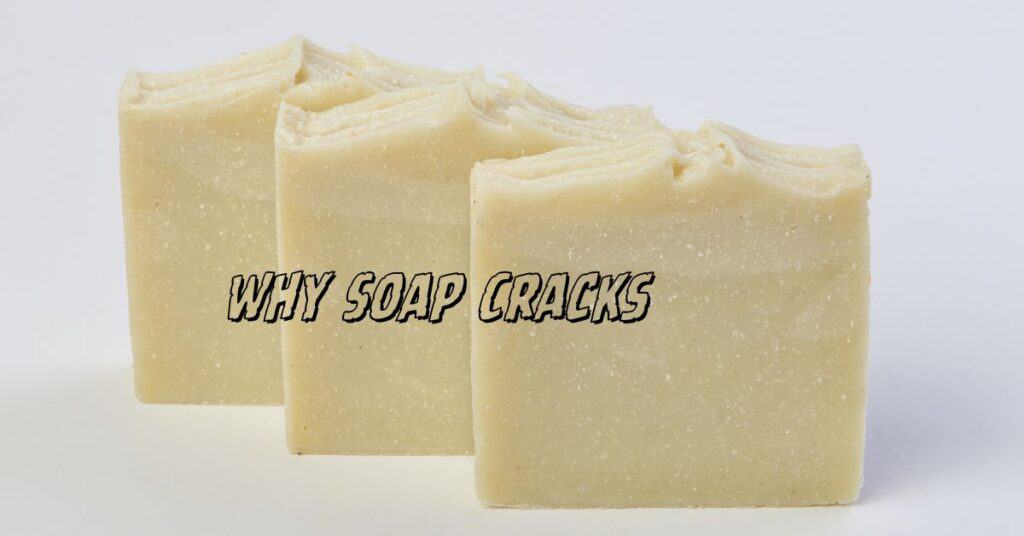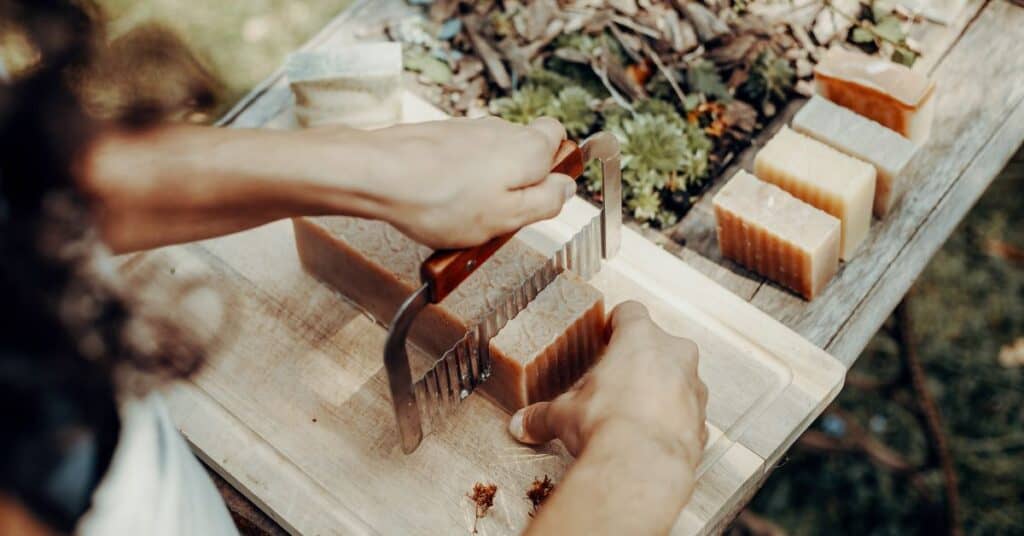Table of Contents
What are the reasons why soap cracks? Temperature, recipe, and quantity of lye in the soap.
When soaping, sometimes the unexpected can happen. One such occurrence is soap cracking while it is still in the mold or gel phase after recently being poured.
It can affect the appearance of your soap and can be frustrating to deal with.
As a soap maker, I have experienced this firsthand, and it’s not bad because it can be fixed. But what causes soap to crack, and how can you avoid it?
In this post, I will explain why soap cracks and share some tips and tricks to prevent them.
Let’s begin!
What Causes Soap To Crack?
Soap cracking refers to the development of fissures, splits, or fractures on the surface of soap, and it is both typical and unexpected in bar soap.
These issues can occur during the soap-making process or as the soap cures. More often than not, a crack is due to heat.
The cracks can vary in size and depth, ranging from small, superficial lines to more significant splits that affect the structural integrity of the soap.
Several factors contribute to soap cracking; understanding them is crucial for amateur and experienced soap makers.
Here are some common reasons why soap may crack:
- Soaping with high temperatures (140 °F and above). The ideal temperature for making soap is around 110-130°F.
If your oils or lye solution are too hot, or your soap goes through the gel phase, it can reach temperatures up to 180°F or higher, causing the soap to crack.
The gel phase is an ideal phenomenon in soap making but can be a drawback when you use certain ingredients and tools that make soap susceptible to cracking.
For example, when you make soap with ingredients like milk, honey, coffee, fruits, wine, or tea or use a mold that can’t hold heat, put your soap batter in a refrigerator to prevent cracking or decoloration.
When the soap is exposed to a sudden or drastic drop in temperature, it creates stress within the soap structure.
The outer layer may cool and solidify faster than the inner layers, leading to uneven contraction and potential cracks.
- The soap contains a large amount of solid oils, butter, or wax.
These ingredients tend to make your soap more brittle and prone to cracking.
They also raise the temperature of your soap during saponification, the chemical reaction that turns oils and lye into soap.
I recommend limiting the amount of butters to 15% of your total oils and the amount of beeswax to 8% or less.
- Lye heaviness: This is when you use too much lye in your soap recipe, resulting in a dry and harsh soap.
Heavy lye soap can also generate more heat during saponification and crack as it cools down.
Incomplete emulsification or uneven mixing of ingredients can create weak points in the soap, making it susceptible to cracking.
To avoid this, ensure to use a reliable soap calculator to measure your ingredients accurately, and test the pH of your soap to ensure it is not too alkaline.
- Additives: Some ingredients you add to your soap can increase the chance of overheating and cracking.
As stated earlier, These include sugar, honey, milk, purees, and some essential or fragrance oils.
These additives can promote the gel phase or cause the soap to react differently with the lye. For example, honey can cause the soap to turn dark brown and bubble up in the mold.
- Additionally, clay also plays a significant role in cracking soap; it contains an ingredient that absorbs moisture.
While clays are the most common culprit for cracking, adding too many dry ingredients can contribute to cracks.
For example, using lots of colloidal oatmeal, activated charcoal, or arrowroot powder without additional water or oil may cause the soap to become dry and brittle.
I recommend dispersing them in distilled water.
What To Do When Soap Breaks?
You can take some steps to prevent your soap from cracking or fix it if it does. Here are some suggestions:
Soap cooler: Keep your oils and lye solution at a lower temperature, around 90-130°F, when using the above-stated ingredients.
This will help slow down the saponification process and keep the heat under control.
Additionally, ensure to use a reliable soap calculator to measure your ingredients accurately, and test the pH of your soap to ensure it is not too alkaline.
Don’t insulate your mold: Insulating it means wrapping it with a towel or a blanket to keep the heat in.
This can help achieve gel phase, but it can also cause your soap to overheat and crack if it contains the ingredients I listed.
(Not recommended for the sugar-containing recipes listed above as they will darken)
Skip the insulation and let your soap cool down naturally. You can also put your soap before a fan or in a cool place to speed up the cooling process.
Put your soap in the fridge or freezer: If you use additives that tend to heat up your soap, such as milk, clay, or honey, you can put your soap in the fridge or freezer right after pouring it into the mold.
This will help prevent the gel phase and cracking and preserve the color and scent of your soap.
You can leave your soap in the fridge or freezer for 6-24 hours, depending on the size and shape of your mold.
Fix your cracked soap: If your soap does crack, don’t worry. You can still use it or fix it. As long as your soap is not lye-heavy, it is safe to use.
Spray rubbing alcohol (evergreen alcohol is what I use), cut cling firm the size of the crack on your soap, and then use your hand to push the soap together and smooth it with a gloved finger.
Or you can make patting motions and pat down.
You also have the option of cutting off the cracked part and re-batching it because the smaller your crack, the better your chances of fixing it.
Re-batching is when you melt down your soap and re-mold it.
Why Does Soap Dry Out And Crack?
- Overheating: Some ingredients, such as honey, sugar, or milk, can cause the soap to heat up excessively and crack to release the trapped heat.
- Moisture changes: The soap expands and contracts as its moisture content changes due to the wet environment. This causes fatigue and cracks on the surface of the soap.
- Dry ingredients: Some ingredients, such as clay, oatmeal, or charcoal, can absorb moisture and dry the soap. This can make the soap brittle and prone to cracking.
Conclusion
With these tips and tricks, you can make beautiful, crack-free soap that you and your customers will love.
Soap cracking is a regular thing. It happens to the best of us, just like any other thing in life. Soap-making is not an exception. The critical factor is knowing the cause and finding the solution.
Remember, to formulate a crack-free soap; caution is required on your path to avoid things that result from it.



